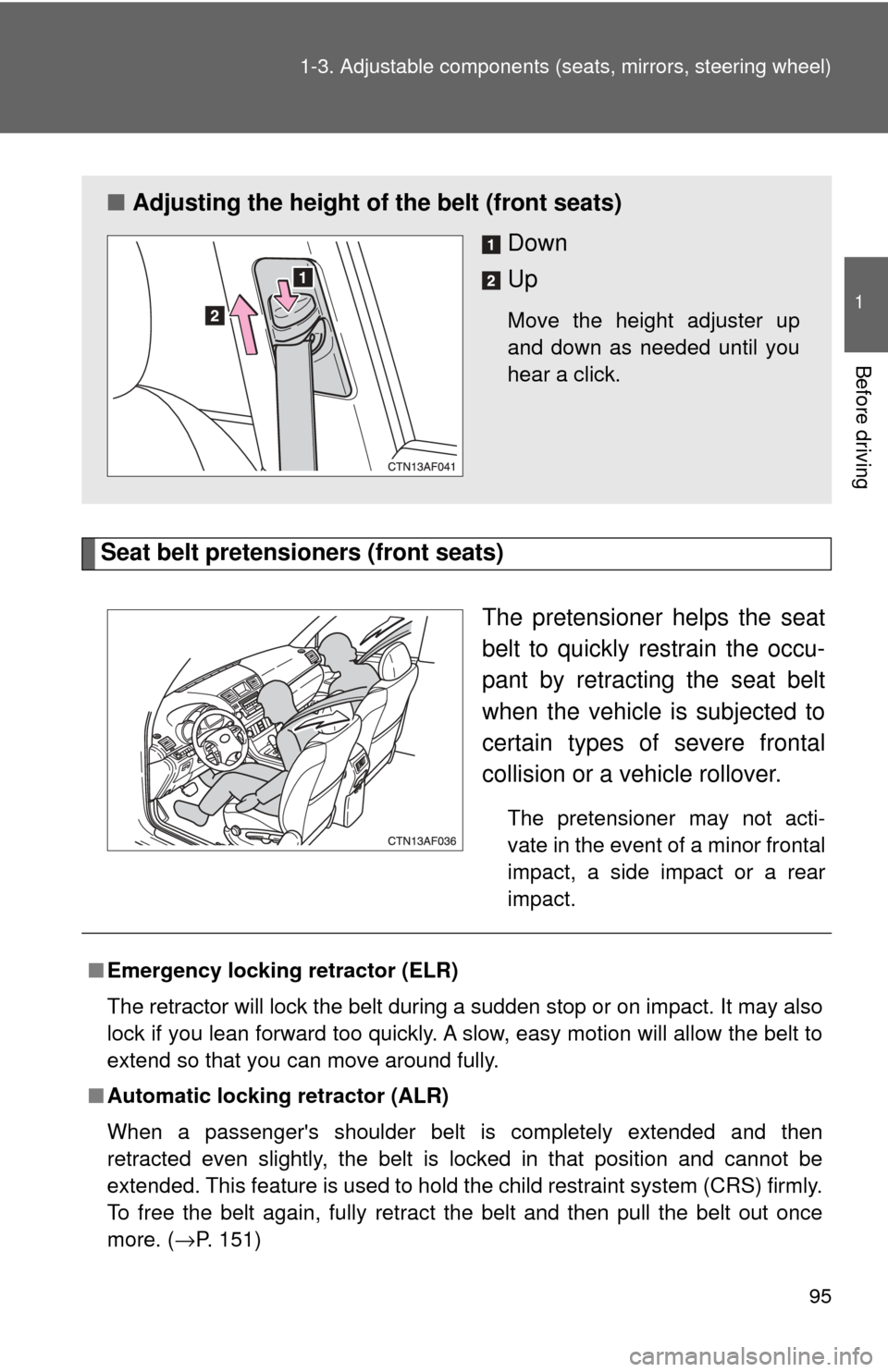Page 79 of 608
79
1
Before driving
1-3. Adjustable components (seats, mirrors, steering wheel)
Front seats
Manual seat
Seat position adjustment lever
Seatback angle adjustment lever
Vertical height adjustment lever (driver’s side only)
Seat cushion (front) angle adjustment knob (driver’s side only)
Pull up the lever until the lock is completely released.
Page 80 of 608
80 1-3. Adjustable components (seats, mirrors, steering wheel)
Active head restraints
When the occupant’s lower back
presses against the seatback
during a rear-end collision, the
head restraint moves slightly for-
ward and upward to help reduce
the risk of whiplash on the seat
occupant.
Power seat
Seat position adjustment switch
Seatback angle adjustment switch
Seat cushion (front) angle adjustment switch (driver’s side only)
Vertical height adjustment switch (driver’s side only)
Driver’s seat leg support adjustment switch (if equipped)
Seat lumbar support adjustment switch (driver’s side only)
Page 92 of 608
92 1-3. Adjustable components (seats, mirrors, steering wheel)
■Adjusting the height of the head restraints (except second center seat
and third seats)
■ Removing the front and second seat outer head restraints
Pull the head restraint up while pushing the lock release button.
While pushing in the screwdriver, pull up the head restraint.
■When using the third seat head restraints (vehicles with
third seats)
To u s e
To f o l d
Make sure that the head restraints are
adjusted so that the center of the head
restraint is closest to the top of your ears.
STEP1
Push a flathead screwdriver into the slot.
(The slot is located on the opposite side
of the head restraint to the lock released
button.)STEP2
STEP3
Page 95 of 608

95
1-3. Adjustable components (s
eats, mirrors, steering wheel)
1
Before driving
Seat belt pretensioners (front seats)
The pretensioner helps the seat
belt to quickly restrain the occu-
pant by retracting the seat belt
when the vehicle is subjected to
certain types of severe frontal
collision or a vehicle rollover.
The pretensioner may not acti-
vate in the event of a minor frontal
impact, a side impact or a rear
impact.
■Adjusting the height of the belt (front seats)
Down
Up
Move the height adjuster up
and down as needed until you
hear a click.
■Emergency locking retractor (ELR)
The retractor will lock the belt during a sudden stop or on impact. It may also
lock if you lean forward too quickly. A slow, easy motion will allow the belt to
extend so that you can move around fully.
■ Automatic locking retractor (ALR)
When a passenger's shoulder belt is completely extended and then
retracted even slightly, the belt is locked in that position and cannot be
extended. This feature is used to hold the child restraint system (CRS) firmly.
To free the belt again, fully retract the belt and then pull the belt out once
more. ( →P. 151)
Page 228 of 608
228
2-5. Driving information
Off-road precautions
Off-road vehicle feature● Specific design characteristics give it a higher center of gravity
than ordinary passenger cars. This vehicle design feature causes
this type of vehicle to be more likely to rollover. And, utility vehicles
have a significantly higher rollover rate than other types of vehi-
cles.
● An advantage of the higher ground clearance is a better view of the
road allowing you to anticipate problems.
● It is not designed for cornering at the same speeds as ordinary
passenger cars any more than low-slung sports cars designed to
perform satisfactorily under off-road conditions. Therefore, sharp
turns at excessive speeds may cause rollover.
This vehicle belongs to the utility vehicle class, which has higher
ground clearance and narrower tread in relation to the height of its
center of gravity to make it capa ble of performing in a wide variety
of off-road applications.
Page 552 of 608
552
6-1. Specifications
Maintenance data (fuel, oil level, etc.)
Dimensions and weights
*1: GVM condition
*2: Without towing package
*3: With towing package
Overall length188.4 in. (4785 mm)
Overall width75.2 in. (1910 mm)
Overall height Without roof rails
68.1 in. (1730 mm)
With roof rails
69.3 in. (1760 mm)
Wheelbase
109.8 in. (2790 mm)
Front tread 64.0 in. (1625 mm)
64.2 in. (1630 mm)*1
Rear tread
2WD models64.2 in. (1630 mm)
64.8 in. (1645 mm)*1
4WD models64.0 in. (1625 mm)
64.6 in. (1640 mm)*1
Vehicle capacity weight
(Occupant + luggage) 1200 lb. (544 kg)
Towing
capacity
(Trailer
weight +
cargo)2.7 L 4-cylin-
der (1AR-FE)
engine1500 lb. (680 kg)*2
3500 lb. (1500 kg)*3
3.5 L V6
(2GR-FE)
engine2000 lb. (900 kg)*2
5000 lb. (2000 kg)*3
Page 573 of 608
573
6-1. Specifications
6
Vehicle specifications
Tire size
■ Typical tire size information
The illustration indicates typical
tire size.
Tire use
(P = Passenger car,
T = Temporary use)
Section width (millimeters)
Aspect ratio
(tire height to section width)
Tire construction code
(R = Radial, D = Diagonal)
Wheel diameter (inches)
Load index (2 digits or 3 digits)
Speed symbol
(alphabet with one letter)
■ Tire dimensions
Section width
Tire height
Wheel diameter